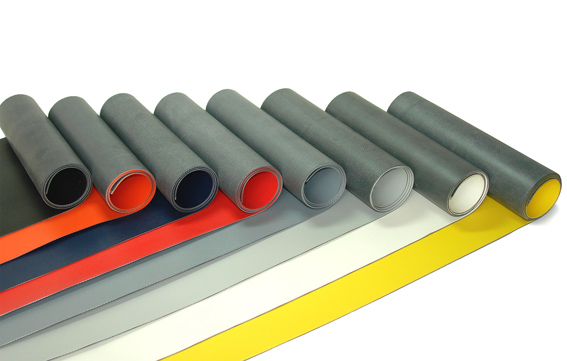As an Amazon Associate, I earn from qualifying purchases. This is without any additional costs for the buyer but does support me in maintaining my website.
When deciding which inflatable boat you want to buy, there are a couple of things to keep in mind. Most commercially available boats that you find today are made from one of three different materials, Neoprene/CSM (Also called Hypalon), PVC, or Polyurethane. Each material has its advantages and disadvantages, so make sure to read the properties of each material carefully before deciding. Choosing the wrong material can be the difference between having a blast or having your day ruined.
Neoprene/CSM (Hypalon)
Two very common types of materials used in inflatable boat making are CSM and Neoprene. CSM is made out of a rubber called chlorosulfonated polyethylene. CSM on its own doesn’t work very well, mostly because it’s not able to hold any air.
That’s why most manufacturers use a mix of Neoprene and CSM to create the ultimate inflatable boat material. Neoprene holds air like no other material, it’s extremely airtight and has a long lifespan. The first inflatable boats actually used cotton coated with Neoprene. It worked great with one exception, the cotton would quickly rot away while the Neoprene would remain intact.
The Neoprene/CSM combo is also known as “Hypalon”. It was the tradename for DuPont’s CSM, but they discontinued their rubber in 2010. People do however still call the Neorepene/CSM combo “Hypalon”.
Coating an inflatable with CSM is smart for various reasons. First and foremost, it has a high UV tolerance, which means it will not harden if left out in the sun. Second, it’s resistant to chemicals, so spilling oil or fuel when filling up is no problem. Thirdly, it’s very easy to repair, much like PVC boats. Just bring out a patch and apply it to your boat, perfect for when your inflatable needs a quick fix out on the lake. Last but not least, it has good abrasion resistance, meaning you’re not very likely to get any holes in your boat if you were to scrape against a hard surface.
Pros
- CSM/Neoprene is abrasion resistant, much more than PVC but less than Polyurethane.
- Chemical and UV resistant.
- Doesn’t deteriorate over time compared to materials like PVC
Cons
- The most expensive coated material, which brings up the costs of the boats
- Get’s dirty rather quickly due to the material being porous.
- The color on the coating is no UV resistant, it will fade over time.
PVC
Short for polyvinyl chloride, it’s a synthetic plastic polymer. PVC comes in two basic forms, a rigid and flexible one. PVC is used for all kinds of things, sewage pipes, clothing, furniture, toys, and of course, inflatable boats.
To make inflatable PVC boats ready for the water, they have to add a bunch of chemicals. Things like pigments, plasticizers, UV stabilizers, and heat stabilizers are all added to the boat fabric. While all these extra chemicals make the boat work better, they’re not very environmentally friendly. Another downside is that these chemicals leach out over time, meaning they lose their effect and slowly but steadily break down the PVC fabric of your boat.
If you’re getting an inflatable boat that is on the cheaper side, it will most likely be made out of PVC fabric, which is not necessarily a bad thing. Just keep in mind that the boat will not last as long as some of the more expensive ones. In the inflatable boat world, you get what you pay for.
Pros:
- PVC is easy to repair by either gluing or welding new sheets of PVC.
- It’s very abrasion resistant when wet.
- Finding cheap inflatables has never been easier thanks to PVC.
Cons:
- PVC has almost no abrasion resistance when dry.
- It’s not as UV resistant as other fabrics.
- Inflatable PVC boats deteriorate over time, meaning they become brittle and fragile.
Polyurethane
This material has been ignored by the inflatable boat manufacturing world for years, it’s only in ‘recent’ years that it’s been gaining attention. Manufacturers ignored polyurethane fabric because it was too stiff and would often go even stiffer after long exposure to UV light. A long day out on the lake on a sunny day could potentially ruin your boat. This made them unsuitable for folding inflatable boats.
Luckily technology has improved a lot since then. Nowadays more and more inflatable boat companies are offering polyurethane boat fabric. Many claims that an inflatable boat made from polyurethane fabric will withstand much more abuse and last a lot longer than those made with PVC or neoprene/CSM. It’s the most abrasion-resistant inflatable boat fabric to date, it’s also more puncture resistant than any other material. As an added bonus to all that, it has the least negative environmental impact of all three.
Polyurethane inflatable boats are the most expensive ones and are generally a lot harder to find online. Unless you’re looking for something really high end and know why you’d need a Polyurethane inflatable, we suggest buying a Neoprene/CSM (Hypalon) boat.
Pros
- The most abrasion resistant inflatable boat fabric
- The most puncture-resistant
Cons
- More expensive than PVC and neoprene
- Harder to repair and weld





